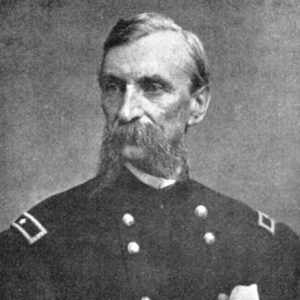calsfoundation@cals.org
Action at Bentonville
| Location: | Benton County |
| Campaign: | Pea Ridge Campaign |
| Date: | February 18, 1862 |
| Principal Commanders: | Brigadier General Alexander Asboth (US); Unknown (CS) |
| Forces Engaged: | Fourth and Fifth Missouri Cavalry Regiments (detachments), First Missouri Flying Battery (US); Seventeenth Arkansas Infantry (CS) |
| Estimated Casualties: | 1 (US); 32 (CS) |
| Result: | Union victory |
The Action at Bentonville occurred on February 18, 1862, as Brigadier General Samuel R. Curtis sought to maneuver Confederate forces from their winter encampment at Cross Hollows in the Boston Mountains.
Curtis had entered Arkansas the previous morning in pursuit of Sterling Price’s Missouri State Guard, troops he had chased from southwest Missouri. Curtis’s Army of the Southwest rolled forward with little opposition until encountering Confederate regulars under Colonel Louis Hébert just south of Little Sugar Creek at a place called Dunagin’s Farm. Hébert’s force of infantry and cavalry, supported by artillery, fought a stubborn rearguard action that halted Curtis’s advance, costing the Federals thirteen dead and around twenty wounded while suffering as many as twenty-six dead on the Rebel side.
Curtis believed the Confederate winter encampment at Cross Hollows was well-fortified and decided on February 18 to scout the area and determine a means of repelling the Rebels from their earthworks. He accordingly sent scouts west of the Telegraph Road to see if Cross Hollows could be flanked from its left. He also sent a strong column of cavalry toward Bentonville (Benton County).
The strike force that attacked Bentonville consisted of men of the Fourth and Fifth Missouri Cavalry Regiments, backed by the firepower of the First Missouri Flying Battery. Their commander was Alexander Sandor Asboth of Brigadier General Franz Sigel’s Union Division. Asboth was Hungarian by birth, having moved into exile in the United States after the failed uprising against Austria in 1848. General John C. Fremont had sought his services as a brigadier general in charge of volunteers and as a chief of staff, and Asboth had fought well with cavalry in Missouri in 1861.
After scattering a Rebel picket post four miles east of Bentonville, Asboth’s column roared into town at twenty minutes past noon, surprising soldiers from Colonel Frank Rector’s Seventeenth Arkansas Infantry Regiment who were clearing out equipment left behind when Hébert’s troops left their camp to confront Curtis’s army. The Federals captured thirty-two Rebel soldiers, four wagonloads of food and equipment, three dozen horses, the papers of the Confederate post quartermaster, mail, $475.75 in Confederate currency, and the Seventeenth Arkansas’s regimental flag.
After administering the oath of allegiance to the citizens of Bentonville, the Federal column returned to the main Union force by 7:30 p.m. The only Union casualty of the affair occurred when a trooper of the Fifth Missouri Cavalry returned to town to fill his canteen with whiskey. A Confederate shot him twice in the head, and the people of Bentonville hid his body in an outhouse. After a Federal search party found the corpse, they set fire to Bentonville, burning much of the town.
The chief result of the Action at Bentonville was the intelligence gathered by Asboth’s troops, from which General Curtis determined that he would be able to send troops to the west to maneuver the Confederates out of their position at Cross Hollow. Rebel commander Ben McCulloch came to the same realization, and the next morning the Rebel troops retreated deeper into the Boston Mountains through the freezing rain after setting their camp afire. This helped set the stage for future movements by both armies that resulted in the climactic Battle of Pea Ridge a few weeks later.
For additional information:
Christ, Mark K., ed. Rugged and Sublime: The Civil War in Arkansas. Fayetteville: University of Arkansas Press, 1994.
Shea, William, and Earl Hess. Pea Ridge: Civil War Campaign in the West. Chapel Hill: University of North Carolina Press, 1992.
The War of the Rebellion: A Compilation of the Official Records of the Union and Confederate Armies. Series 1, vol. 8. Washington DC: Government Printing Office, 1890–1901, p. 62–64.
Warner, Ezra J. Generals in Blue: Lives of the Union Commanders. Baton Rouge: Louisiana State University Press, 1964.
Mark K. Christ
Little Rock, Arkansas
 Civil War Timeline
Civil War Timeline Military
Military Alexander Asboth
Alexander Asboth  Samuel Curtis
Samuel Curtis 



Comments
No comments on this entry yet.